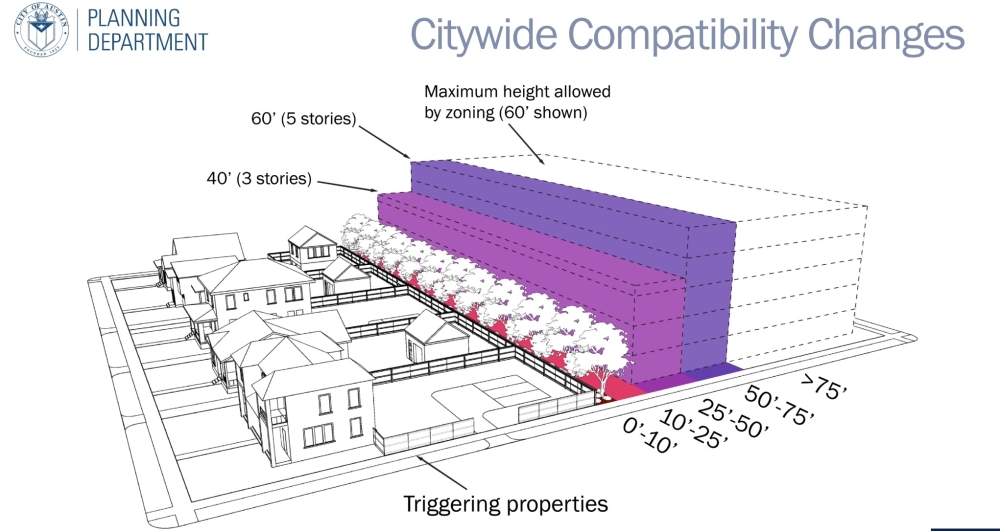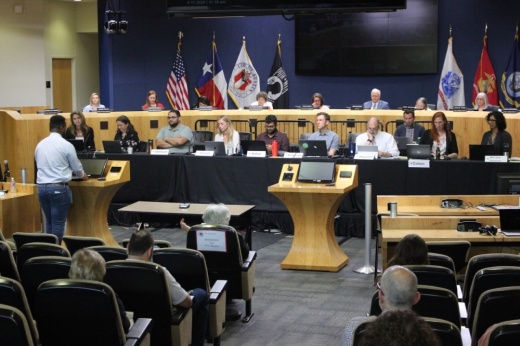The changes stem from many elected officials' desire to increase the amount of housing in the city, through strategies they and city planners hope will make more types of housing attainable for more Austinites. The code amendments are also aimed at better tying new development to the proposed Project Connect transit system and meet city mobility goals.
"Folks were clear—we need to work to make Austin a more affordable, open community. We can get there with more housing and transit-supportive density," Mayor Kirk Watson said on social media after the hearing.
The setup
Four revisions to Austin's land-use rules are under consideration this spring.
- Home Options for Middle-income Empowerment, or HOME, Phase 2, described by city staff as "soft density by right," would reduce the amount of land needed to build a residential housing unit by about two-thirds and adjust other design standards for small lots. Coupled with HOME Phase 1 allowing up to three housing units on residential lots, the revision is intended to bring smaller, more affordable homeownership options across more of Austin. The existing 5,750-square-foot minimum lot size would still remain for single-family sites with two or three units. A staff analysis is available here.

City Council is considering changes to single-family development rules. (Courtesy city of Austin) - Compatibility cuts would reduce the influence of single-family housing on the size of new buildings nearby. The new rules would apply compatibility standards up to 75 feet away from existing homes, down substantially from today’s 540-foot reach. Staff believe there’s room to unlock tens of thousands of housing units that can't be built under the existing standards, which also stretch much farther than in similar cities. A staff analysis is available here.

City Council is considering greater allowances for development near single-family homes. (Courtesy city of Austin) - ETOD overlays linked to Austin's equitable transit-oriented development, or ETOD, goals would place new zoning regulations on select properties near the future Project Connect light rail line. New building programs would would encourage denser residential projects with affordable housing—or fee payments to the city—and other transit-friendly uses, while phasing out some commercial uses for the future. The proposal also includes anti-displacement measures if naturally affordable housing is redeveloped under the new rules. A map of affected properties is available here, and a staff analysis is available here.

City Council is considering code revisions to encourage more transit-friendly development along Austin's future light rail system. (Courtesy city of Austin) - Electric vehicle charging rules: The change would limit where new EV charging stations could be built, mainly concentrating them outside of neighborhoods and near major roadways. A staff report is available here.
Nearly 180 people registered to testify April 11. Of those, most supported the measures, with about one-third against.
Backers stressed their belief that allowing smaller homes on smaller lots is an effective way to boost middle-class homeownership, and reverse a longtime trend of building larger and more expensive housing.
Economist Michael Nahas said Austin's prevalent large lots have made it impossible to create enough homes for lower- and middle-income Austinites, leaving options only at the upper end.
“We have lots only for the wealthy in Austin. We need to create more,” he said.
As in other recent public discussions, many favoring the code changes said Austin is long overdue for major zoning reforms and must emphasize planning for transit as new networks are developed. Several University of Texas students also voiced their support for the changes and their desire to remain in town after graduation, if policies aimed at affordability are successful.
Electrician Fernando Arista said he views HOME and related plans—coupled with living wages and rental assistance—as a chance to create options for local workers who've struggled to find a place to live.
“For seven years I’ve helped build some of the high-rises around here, including Google and Facebook. I’ve also helped build Tesla, Amazon, and houses, hospitals and schools. And I haven’t been able to afford a home here in Austin in the seven years that I’ve helped build it," he said.
Concern about HOME and other far-reaching zoning reforms continued to come from some in Austin's central neighborhoods and lower-density areas farther from downtown.
Bruce Greiner said he and his wife decided to buy a home in Northwest Austin's Spicewood Estates, a community he views as offering homes with larger yards, safety and good schools. Greiner said those aspects could be at risk under new plans, and pushed back on the "fanciful" notion that added density would promote transit use farther from Central Austin.
“If we wanted to live in a more densely populated area, we would have done so," he said. "There are many neighborhoods across Austin just like ours. Whether in North or South Austin they were built for suburban living ... they are many miles from downtown with little or no access to public transit, no shopping within a walkable distance and require a car for professional services."
Reception from several East Austin residents and activists also centered on concern about impacts on minority and lower-income communities that have been feeling displacement pressures for years. Nyeka Arnold labeled the plans as "systematically racist" and most impactful for east siders.
"Low-income, BIPOC neighborhoods will be targeted first by developers because land is cheaper in the Eastern Crescent given higher profit margins," Arnold said. "All of these policies will drive up housing costs, making the housing affordability crisis worse for everyone. These developers are trying to build a new city and make Austin their example."
The full hearing can be viewed here.
What's next
The April hearing before members of City Council and the Planning Commission—their second joint land-use hearing in recent months—was the first step of a public engagement process expected to end mid-May.
Open houses are scheduled for April 17 and 20. The Planning Commission will then take up the items at April 23 and 30 meetings.
Council could take additional time for review before its scheduled final votes May 16.
More information on each proposal is available from the city online.





